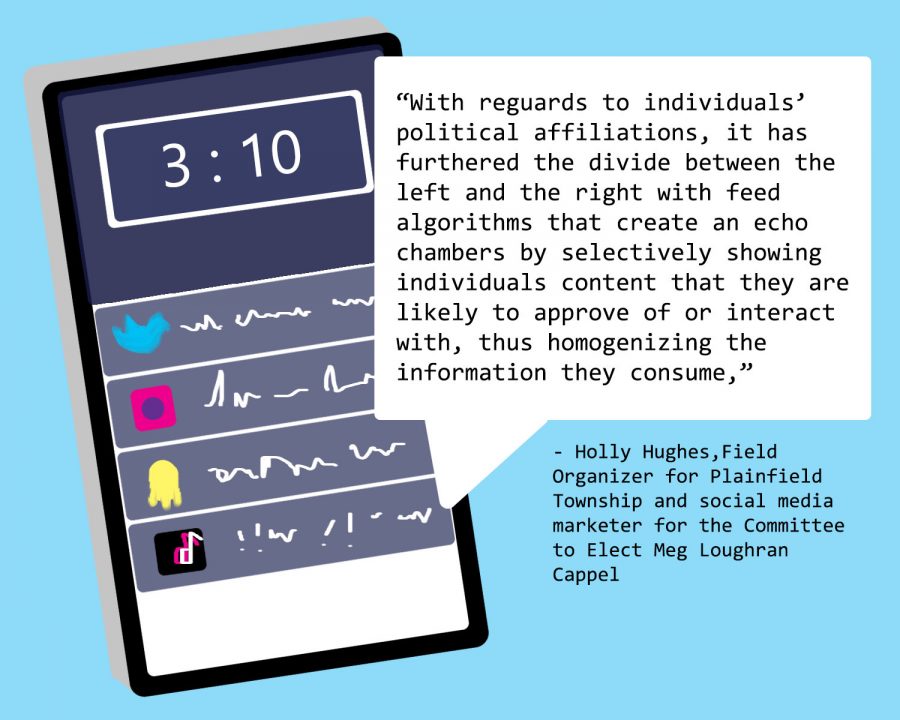The political age of social media
November 6, 2020
Social media had become an increasingly prevalent force in teenage lives. It is a platform for people to communicate and have their voices heard, but social media has evolved in recent years into political media. This shift towards political usage of social media has been simultaneously positive and negative.
Social media is a recent fixture in the political sphere. In the 1980s, more traditional media such as television, radio, and newspapers were the main source of political information. This broadened in the 1990s when the internet was first introduced, though traditional media remained the main political source. It was not until Obama used social media in his 2008 campaign that social media politics became popular, according to the article “The Past Decades and Future of Political Media: The Ascendance of Social Media.”
But there was also a shift in social media usage from teens and young adults to usage by every age range.
“[There is] more of all age groups, young and old,” said former Plainfield South student Keely Smith.
The social media populace increased in both numbers and diversity as we approached the late 2000s which enticed political leaders to join social media in order to spread their message faster to larger groups of people.
“It’s a new way to reach out to all demographics now. So your message is now shared amongst all ages,” says Cameron Baltrum, a junior at Plainfield East and Vice-chair of the Plainfield High School Democrats.
Politicians now use social media as the main platform for personal political matters such as sharing ideas on new policy or policy changes, advocating for political and social issues, and contacting other politicians. However, they also use social media for campaigning.
“We use social media to engage our base, make them aware of volunteer or activist opportunities, and promote upcoming events or endorsements,” says Holly Hughes, the Field Organizer for Plainfield Township and social media marketer for the Committee to Elect Meg Loughran Cappel.
The influence of political social media is not only controlled by politicians and their campaigns but regular users, too.
Social media platforms generally are not very restrictive, following only a list of guidelines on what can and cannot be posted. This allows for a diverse social media population where many different people can share many different ideas.
This applies to the student population as well, as Baltrum and Augustus Davis Jr, a Plainfield South senior who operates a relatively large political Twitter account, both post about political happenings and engage in online discussions with their followers and those they follow. This engagement students have on social media can be very influential to the online community.
“Younger people are who are fueling change from protesting to rights and information. Having older generations helps not only inform them [of] the world and what young people are doing but helps with communication,” Smith says.
This communication has led to many communities, young and old, coming together to create positive change such as the #MeToo and Black Lives Matter movements.
Unfortunately, widespread communication and easy access to social media come with faults. Easy access allows many hate groups and slanderers from both the radical right and left to parade social media while widespread communication allows these groups to spread misinformation quickly and easily.
“Social media is a double-edged sword in regards to its effect on politics. On one hand, it allows people to communicate with one another and exchange ideas really easily. On the other hand, it opens the gates to misinformation, disinformation, and political controversy and volatile and toxic political discourse that can cause people to act in ways that harm others in the real world,” says Davis.
This plethora of information on social media makes it difficult for people to determine what is real, perpetuating the cycle of misinformation. Politicians often reinforce misinformation now if it supports their cause. This leads to an increased polarization between the parties, which social media uses to show posts that lean towards your political opinion.
“With regards to individuals’ political affiliations, it has furthered the divide between the left and the right with feed algorithms that create echo chambers by selectively showing individuals content that they are likely to approve of or interact with, thus homogenizing the information they consume,” Hughes said.
This grouping of political parties on social media furthers the differences in perceptions of issues in political parties, essentially creating two different worlds. This, along with the clickbait nature of social media, has made politics lose any semblance of civility with the production of attack ads, and exposing scandals towards other politicians.
This lack of civility and prevalence of misinformation in political social media is why all users need to practice caution on social media. Users need to learn how to determine what sources are credible and to fact-check politicians, political groups, news sources, and general posts on social media that claim something as fact.



